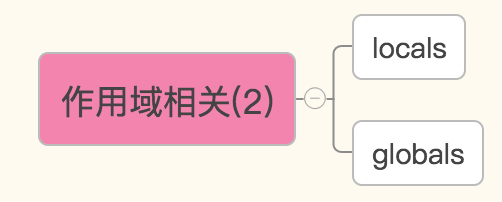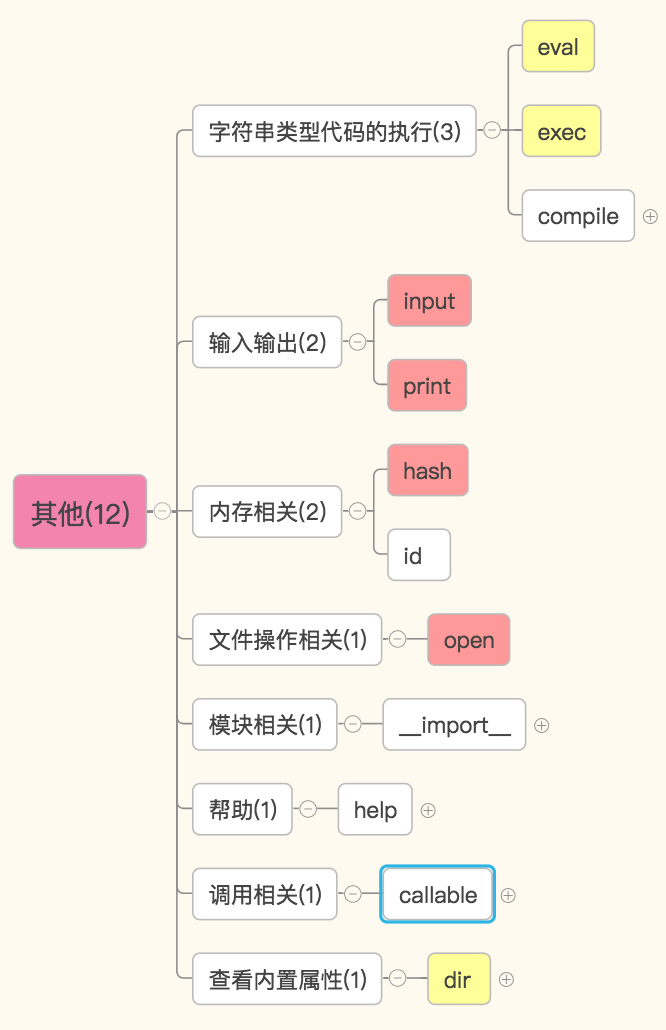python笔记之内置函数和匿名函数
内置函数和匿名函数
内置函数
接下来,我们就一起来看看python里的内置函数。截止到python版本3.6.2,现在python一共为我们提供了68个内置函数

作用域相关

基于字典的形式获取局部变量和全局变量
globals()——获取全局变量的字典
locals()——获取执行本方法所在命名空间内的局部变量的字典
其他

字符串类型代码的执行
eval
eval() 函数用来执行一个字符串表达式,并返回表达式的值
>>>eval('1+2+3+4') 10
exec
exec()将自字符串类型的代码执行
>>> print(exec("1+2+3+4")) None >>> exec("print('hello,world')") hello,world

code = ''' import os print(os.path.abspath('.')) ''' code = ''' print(123) a = 20 print(a) ''' a = 10 exec(code,{'print':print},) print(a)
compile
compile 将字符串类型的代码编译。代码对象能够通过exec语句来执行或者eval()进行求值。
参数说明:
1. 参数source:字符串或者AST(Abstract Syntax Trees)对象。即需要动态执行的代码段。
2. 参数 filename:代码文件名称,如果不是从文件读取代码则传递一些可辨认的值。当传入了source参数时,filename参数传入空字符即可。
3. 参数model:指定编译代码的种类,可以指定为 ‘exec’,’eval’,’single’。当source中包含流程语句时,model应指定为‘exec’;当source中只包含一个简单的求值表达式,model应指定为‘eval’;当source中包含了交互式命令语句,model应指定为'single'。
>>> #流程语句使用exec >>> code1 = 'for i in range(0,10): print (i)' >>> compile1 = compile(code1,'','exec') >>> exec (compile1) 0
1
2
...... 8
9 >>> #简单求值表达式用eval >>> code2 = '1 + 2 + 3 + 4' >>> compile2 = compile(code2,'','eval') >>> eval(compile2) >>> #交互语句用single >>> code3 = 'name = input("please input your name:")' >>> compile3 = compile(code3,'','single') >>> name #执行前name变量不存在 Traceback (most recent call last): File "<pyshell#29>", line 1, in <module> name NameError: name 'name' is not defined >>> exec(compile3) #执行时显示交互命令,提示输入 please input your name:'pythoner' >>> name #执行后name变量有值 "name"
输入输出相关
input() 输入

s = input("请输入内容 : ") #输入的内容赋值给s变量 print(s) #输入什么打印什么。数据类型是str
print() 输出

def print(self, *args, sep=' ', end='\n', file=None): # known special case of print """ print(value, ..., sep=' ', end='\n', file=sys.stdout, flush=False) file: 默认是输出到屏幕,如果设置为文件句柄,输出到文件 sep: 打印多个值之间的分隔符,默认为空格 end: 每一次打印的结尾,默认为换行符 flush: 立即把内容输出到流文件,不作缓存 """ print源码剖析

f = open('tmp_file','w') print(123,456,sep=',',file = f,flush=True)

import time for i in range(0,101,2): time.sleep(0.1) char_num = i//2 #打印多少个'*' per_str = '\r%s%% : %s\n' % (i, '*' * char_num) if i == 100 else '\r%s%% : %s'%(i,'*'*char_num) print(per_str,end='', flush=True) #小越越 : \r 可以把光标移动到行首但不换行
数据类型相关
type(o) 返回变量o的数据类型
内存相关
id(o) o是参数,返回一个变量的内存地址
hash(o) o是参数,返回一个可hash变量的哈希值,不可hash的变量被hash之后会报错。

t = (1,2,3) l = [1,2,3] print(hash(t)) #可hash print(hash(l)) #会报错 ''' 结果: TypeError: unhashable type: 'list' '''
hash函数会根据一个内部的算法对当前可hash变量进行处理,返回一个int数字。
*每一次执行程序,内容相同的变量hash值在这一次执行过程中不会发生改变。
文件操作相关
open() 打开一个文件,返回一个文件操作符(文件句柄)
操作文件的模式有r,w,a,r+,w+,a+ 共6种,每一种方式都可以用二进制的形式操作(rb,wb,ab,rb+,wb+,ab+)
可以用encoding指定编码.
模块操作相关
__import__导入一个模块

import time

os = __import__('os') print(os.path.abspath('.'))
帮助方法
在控制台执行help()进入帮助模式。可以随意输入变量或者变量的类型。输入q退出
或者直接执行help(o),o是参数,查看和变量o有关的操作。。。
和调用相关
callable(o),o是参数,看这个变量是不是可调用。
如果o是一个函数名,就会返回True

def func():pass print(callable(func)) #参数是函数名,可调用,返回True print(callable(123)) #参数是数字,不可调用,返回False
查看参数所属类型的所有内置方法
dir() 默认查看全局空间内的属性,也接受一个参数,查看这个参数内的方法或变量

print(dir(list)) #查看列表的内置方法 print(dir(int)) #查看整数的内置方法
和数字相关

数字——数据类型相关:bool,int,float,complex
数字——进制转换相关:bin,oct,hex
数字——数学运算:abs,divmod,min,max,sum,round,pow
和数据结构相关

序列——列表和元组相关的:list和tuple
序列——字符串相关的:str,format,bytes,bytearry,memoryview,ord,chr,ascii,repr

ret = bytearray('alex',encoding='utf-8') print(id(ret)) print(ret[0]) ret[0] = 65 print(ret) print(id(ret))

ret = memoryview(bytes('你好',encoding='utf-8')) print(len(ret)) print(bytes(ret[:3]).decode('utf-8')) print(bytes(ret[3:]).decode('utf-8'))
序列:reversed,slice

l = (1,2,23,213,5612,342,43) print(l) print(list(reversed(l)))

l = (1,2,23,213,5612,342,43) sli = slice(1,5,2) print(l[sli])
数据集合——字典和集合:dict,set,frozenset
数据集合:len,sorted,enumerate,all,any,zip,filter,map
filter
filter只管筛选,不会改变原来的值
filter()函数接收一个函数 f 和一个list,这个函数 f 的作用是对每个元素进行判断,返回 True或 False,filter()根据判断结果自动过滤掉不符合条件的元素,返回由符合条件元素组成的新list。
例如,要从一个list [1, 4, 6, 7, 9, 12, 17]中删除偶数,保留奇数,首先,要编写一个判断奇数的函数:
def is_odd(x): return x % 2 == 1
然后,利用filter()过滤掉偶数:
>>>list(filter(is_odd, [1, 4, 6, 7, 9, 12, 17]))
结果:
[1, 7, 9, 17]
利用filter(),可以完成很多有用的功能,例如,删除 None 或者空字符串:
def is_not_empty(s): return s and len(s.strip()) > 0 >>>list(filter(is_not_empty, ['test', None, '', 'str', ' ', 'END']))
结果:
['test', 'str', 'END']
注意: s.strip(rm) 删除 s 字符串中开头、结尾处的 rm 序列的字符。
当rm为空时,默认删除空白符(包括'\n', '\r', '\t', ' '),如下:
>>> a = ' 123' >>> a.strip() '123'
>>> a = '\t\t123\r\n' >>> a.strip() '123'
练习:
请利用filter()过滤出1~100中平方根是整数的数,即结果应该是:
[1, 4, 9, 16, 25, 36, 49, 64, 81, 100]
方法:
import math def is_sqr(x): return math.sqrt(x) % 1 == 0 print(list(filter(is_sqr, range(1, 101))))
结果:
[1, 4, 9, 16, 25, 36, 49, 64, 81, 100]
map
Python中的map函数应用于每一个可迭代的项,返回的是一个结果list。如果有其他的可迭代参数传进来,map函数则会把每一个参数都以相应的处理函数进行迭代处理。map()函数接收两个参数,一个是函数,一个是序列,map将传入的函数依次作用到序列的每个元素,并把结果作为新的list返回。
有一个list, L = [1,2,3,4,5,6,7,8],我们要将f(x)=x^2作用于这个list上,那么我们可以使用map函数处理。
>>> L = [1,2,3,4,] >>> def pow2(x): ... return x*x ... >>> list(map(pow2,L)) [1, 4, 9, 16]
匿名函数
匿名函数:为了解决那些功能很简单的需求而设计的一句话函数
#这段代码 def calc(n): return n**n print(calc(10)) #换成匿名函数 calc = lambda n:n**n print(calc(10))

上面是我们对calc这个匿名函数的分析,下面给出了一个关于匿名函数格式的说明
函数名 = lambda 参数 :返回值 #参数可以有多个,用逗号隔开 #匿名函数不管逻辑多复杂,只能写一行,且逻辑执行结束后的内容就是返回值 #返回值和正常的函数一样可以是任意数据类型
我们可以看出,匿名函数并不是真的不能有名字。
匿名函数的调用和正常的调用也没有什么分别。 就是 函数名(参数) 就可以了~~~
练一练:
请把以下函数变成匿名函数 def add(x,y): return x+y
上面是匿名函数的函数用法。除此之外,匿名函数也不是浪得虚名,它真的可以匿名。在和其他功能函数合作的时候
l=[3,2,100,999,213,1111,31121,333] print(max(l)) dic={'k1':10,'k2':100,'k3':30} print(max(dic)) print(dic[max(dic,key=lambda k:dic[k])])
res = map(lambda x:x**2,[1,5,7,4,8]) for i in res: print(i) 输出 25 16
res = filter(lambda x:x>10,[5,8,11,9,15]) for i in res: print(i) 输出 15
面试题练一练
现有两个元组(('a'),('b')),(('c'),('d')),请使用python中匿名函数生成列表[{'a':'c'},{'b':'d'}]

#答案一 test = lambda t1,t2 :[{i:j} for i,j in zip(t1,t2)] print(test(t1,t2)) #答案二 print(list(map(lambda t:{t[0]:t[1]},zip(t1,t2)))) #还可以这样写 print([{i:j} for i,j in zip(t1,t2)])

1.下面程序的输出结果是: d = lambda p:p*2 t = lambda p:p*3 x = 2 x = d(x) x = t(x) x = d(x) print x 2.现有两元组(('a'),('b')),(('c'),('d')),请使用python中匿名函数生成列表[{'a':'c'},{'b':'d'}] 3.以下代码的输出是什么?请给出答案并解释。 def multipliers(): return [lambda x:i*x for i in range(4)] print([m(2) for m in multipliers()]) 请修改multipliers的定义来产生期望的结果。
本章小结
请务必重点掌握:
其他:input,print,type,hash,open,import,dir
str类型代码执行:eval,exec
数字:bool,int,float,abs,divmod,min,max,sum,round,pow
序列——列表和元组相关的:list和tuple
序列——字符串相关的:str,bytes,repr
序列:reversed,slice
数据集合——字典和集合:dict,set,frozenset
数据集合:len,sorted,enumerate,zip,filter,map
参考文档:


